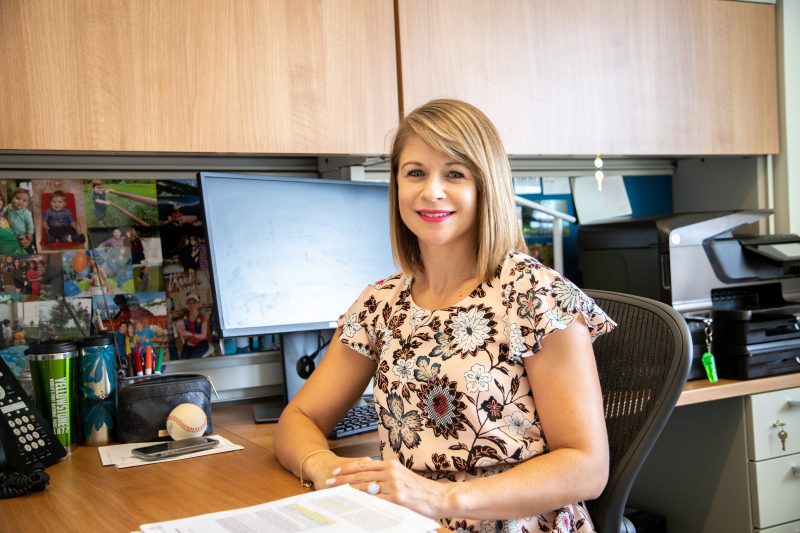Dr. Danieli Rodrigues is an Associate Professor in the department of Bioengineering at UT Dallas. She runs the BONE (Biomaterials for Osseointegration and Novel Engineering) lab to develop novel biomaterials for bone-contacting interfaces to address current challenges related to implant performance and biomaterial-implant-body interactions. Dr. Rodrigues was recently awarded a CoBRA (Collaborative Biomedical Research Award) for her research on A novel immune-interactive surface coating approach to induce implant osseointegration in diabetic conditions with Dr. Javier La Fontaine, Dr. Steven Nielsen, and Dr. George Liu. Dr. Rodrigues hit pause on her research to share the turning point that led her to pursue the project.
Describe your research for a lay audience.
The research conducted in my laboratory focuses on the fundamental aspects of biomaterials that interface with osseous tissues. These materials are used in the design of systems such as total joint replacements, dental implants, fracture fixation devices, and spinal implants. We are specifically looking to characterize factors that interfere with biomaterial surface-bone integration and ways to modulate osseointegration of metallic implants.
Titanium (Ti)-based implants are commonly used to restore the function of damaged bone structures. Due to the success of these implant systems, there were about 5.3 million orthopedic surgeries reported in 2010, and that number is expected to grow to 6.6 million by 2020. Unfortunately, orthopedic implants are considered to be higher risk to diabetic patients due to the decreased wound healing abilities and higher risks for bone fractures. Thus, diabetic patients encounter significantly higher failure rates of Ti implantation, 10-20%, compared to 1-3% in the general population. Moreover, implant failures can have serious consequences in diabetic cases, often resulting in lower limb amputations. This is concerning given that diabetes/pre-diabetes diagnosis is increasing yearly; since 2015, there have been 30.3 million cases (9.4% of the population) in the United States alone.
Failures with orthopedic implants have been associated with corrosion, infection, loading forces, or a combination of multiple causes. All of these factors trigger the immune system to respond negatively, leading to loss of proper binding between the implant and surrounding osseous tissues. Thus, there is an urgent need for strategies for early and enhanced biological fixation of implants in diabetic patients, including new materials, new coatings, and new surface treatments. In an attempt to address this clinical need, our lab has been working on new surface strategies to coat the surface of Ti orthopedic implants with compounds that improve surface properties and/or modulate the inflammatory response towards healing and osseointegration. Thus, our ultimate goal is to boost implant healing in the diabetic population by anchoring host biomolecules on the surface of Ti-based implants.
What happens next in the process of discovery?
We are in the process of synthesizing and characterizing the coating for the first time, which is an imidazolium based ionic liquid-high mobility group box 1 protein compound. The feasibility and functionality of the Ti coating will be investigated with molecular dynamics simulations, in vitro, and in vivo experiments, where Zucker diabetic rats will receive intramedullary implantation with coated and uncoated implants. The CoBRA grant will enable our team to gather key initial data that will support development and feasibility demonstration of this new technology, allowing our team to pursue larger grant opportunities. It will also promote interdisciplinary training while enabling UTD graduate students and residents from UTSW to work together.
Our team brings together expertise on both the materials and clinical sides of the proposed application. Myself and Dr. Javier La Fontaine (Professor, Department of Plastic Surgery, Department of Orthopedic Surgery, UTSW) have a track record in the fields of orthopedic devices, materials for fracture fixation, and osseointegration. Co-investigator, Dr. Steven Nielsen (Associate Professor, Department of Chemistry, UTD) is an expert on theoretical and computational modeling in the fields of bionano systems and complex interfaces. Co-investigator, Dr. George Tye Liu (Associate Professor, Department of Orthopedic Surgery, UTSW) has extensive experience with orthopedic implant devices and implant-host interactions, with focus on diabetic ankle fractures and diabetic Charcot arthropathy.
Can you share a turning point or defining moment in your research?
A turning point happened when I received an invitation to give a talk about failure mechanisms in orthopedic implants at the Diabetic Foot Conference, which is an event organized by the Texas Podiatric Medical Association. I was specifically asked to focus my discussion on the “why” fixation fails in diabetic patients. Although I was generally aware that diabetic patients experience problems with implant integration, I was completely unaware of the high incidence of complications following orthopedic implantation, particularly with lower extremity devices. Looking further into the topic, I noticed there was a lack of studies investigating failure modes of specific implant systems in diabetic cases, and lack of approaches to modulate implant healing with these implants.
After attending this conference, my lab started a pilot project in collaboration with the John Peter Smith Hospital in Fort Worth to characterize the surface of orthopedic implants removed specifically from diabetic patients as a first step in understanding the impact of this immune condition on implant surfaces. We pitched this idea in a NIH F31 Predoctoral fellowship call and the project was awarded right away, in its first submission, which confirmed the significance and clinical need of this research topic.
When you are not working on your research, what do you like to do in your free time?

These days, most of our family free time is filled with activities with our 4-year old son, Samuel. But I still find time to enjoy and practice my sports every day.

You must be logged in to post a comment.